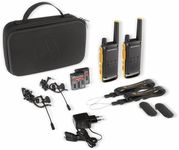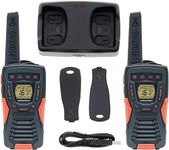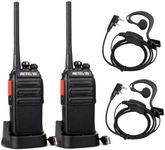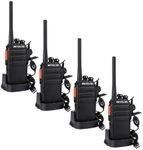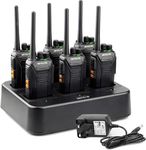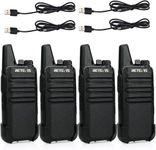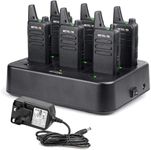Buying Guide for the Best Two Way Radios
Two-way radios, also known as walkie-talkies, are essential communication tools for various activities, from outdoor adventures to professional use in industries like construction or event management. When choosing a two-way radio, it's important to consider the environment in which you'll be using it, the distance you need to cover, and any specific features that might enhance your communication experience. Understanding the key specifications will help you select a radio that meets your needs effectively.Frequency BandThe frequency band determines the range and clarity of communication. Two-way radios typically operate on either UHF (Ultra High Frequency) or VHF (Very High Frequency) bands. UHF radios are better suited for indoor use or areas with obstacles like buildings, as they can penetrate walls and structures more effectively. VHF radios, on the other hand, are ideal for outdoor use with fewer obstructions, such as open fields or water. Choose UHF if you need to communicate in urban or indoor environments, and VHF for open, outdoor settings.
RangeThe range of a two-way radio indicates how far apart users can be while still maintaining clear communication. This is often affected by the environment, with open areas allowing for greater range than urban or forested areas. Radios are typically categorized by their range capabilities: short-range (up to 2 miles), medium-range (2-5 miles), and long-range (5 miles and above). Consider the typical distance between users in your intended use case to determine the appropriate range for your needs.
ChannelsChannels allow users to communicate on different frequencies, which can help avoid interference from other radio users. More channels provide greater flexibility and privacy, especially in crowded areas. Radios can have anywhere from a few to hundreds of channels. If you plan to use the radio in a busy area or need to coordinate with multiple groups, opt for a model with more channels. For simpler, personal use, fewer channels may suffice.
Battery LifeBattery life is crucial for ensuring your radio remains operational throughout your activities. Radios can be powered by rechargeable batteries or disposable ones. Consider how long you need the radio to last on a single charge or set of batteries. For extended use, look for radios with longer battery life or the option to use both rechargeable and disposable batteries. If you have access to charging facilities, rechargeable batteries might be more convenient.
DurabilityDurability refers to the radio's ability to withstand harsh conditions, such as drops, water exposure, and dust. Radios designed for outdoor or industrial use often have rugged, weather-resistant designs. Look for features like water resistance or shockproof construction if you plan to use the radio in challenging environments. For casual or indoor use, a less rugged model may be sufficient.
Size and WeightThe size and weight of a two-way radio can affect its portability and ease of use. Smaller, lighter radios are easier to carry and handle, making them ideal for activities like hiking or camping. Larger radios may offer more features or better durability but can be cumbersome to carry. Consider how you'll be using the radio and choose a size and weight that won't hinder your activities.
